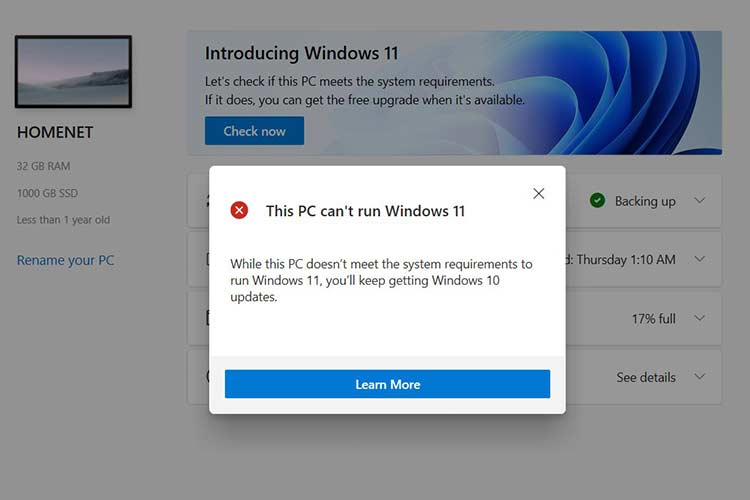Windows 11 System Requirements are the new checkpoint to have your personal computer (PC) ready to run Microsoft’s latest and most advanced operating system ever built. Succeeding Windows 10 which has since 2018 been released in multiple builds with security patches and app upgrades taking a front seat. Windows 11 has been built as a reliable and secure operating system that every user can rely on with fewer updates.
By layout and design, Windows 11 has undergone a complete cosmetic makeover over Windows 10 making it attractive by usage. But with this clean shift in design comes new minimum Windows 11 system requirements every eligible computer must possess. Similar to Apple’s macOS restrictions, most old generation computers may not be able to run Windows 11 without a change in BIOS settings and secure boot options.
So, if compared to Windows 10 system requirements, the minimum Windows 11 system requirements favour newer computers with the Trusted platform model (TPM) running version 2.0 or above. Reason for increased requirements comes as a precaution for all users to feel secure while running Windows 11 since the TPM 2.0 chip provides hardware-based security-related functions to protect users.
Well, besides the hardware-based security TPM requirement, your computer also needs to run at least 4GB RAM or more with a minimum of 64GB free hard disk space to install Windows 11 and preconfigured system software. Also, the trend of running offline accounts is now over, and you’ll need an active Internet connection via Wi-Fi or Ethernet to log in with a Microsoft Outlook account.
Minimum Windows 11 System Requirements
- Processor: 1 gigahertz (GHz) or faster with 2 or more cores on a compatible 64-bit processor or System on a Chip (SoC)
- Memory: 4 GB RAM
- Storage: 64 GB or larger storage device
- System firmware: UEFI, Secure Boot capable
- TPM: TPM Trusted Platform Module (TPM) version 2.0
- Graphics card: Compatible with DirectX 12 or later with WDDM 2.0 driver
- Display: High definition (720p) display, greater than 9-inch diagonally and 8 bits per color channel support
- Internet connection and Microsoft accounts: Windows 11 Home edition requires internet connectivity and a Microsoft account to complete device setup on first use. Switching a device out of Windows 11 Home in S mode also requires internet connectivity.
Feature-Specific Windows 11 Software requirements
- 5G support requires 5G capable modem.
- Auto HDR requires an HDR monitor.
- BitLocker to Go requires a USB flash drive (available in Windows Pro and above editions).
- Client Hyper-V requires a processor with second level address translation (SLAT) capabilities (available in Windows Pro and above editions).
- Cortana requires a microphone and speaker and is currently available on Windows 11 for Australia, Brazil, Canada, China, France, Germany, India, Italy, Japan, Mexico, Spain, United Kingdom, and United States.
- DirectStorage requires an NVMe SSD to store and run games that use the “Standard NVM Express Controller” driver and a DirectX12 GPU with Shader Model 6.0 support.
- DirectX 12 Ultimate is available with supported games and graphics chips.
- Presence requires sensor that can detect human distance from device or intent to interact with device.
- Intelligent Video Conferencing requires video camera, microphone, and speaker (audio output).
- Multiple Voice Assistant (MVA) requires a microphone and speaker.
- Snap three-column layouts require a screen that is 1920 effective pixels or greater in width.
- Mute/Unmute from Taskbar requires video camera, microphone, and speaker (audio output). App must be compatible with feature to enable global mute/unmute.
- Spatial Sound requires supporting hardware and software.
- Teams requires video camera, microphone, and speaker (audio output).
- Touch requires a screen or monitor that supports multi-touch.
- Two-factor Authentication requires use of PIN, biometric (fingerprint reader or illuminated infrared camera), or a phone with Wi-Fi or Bluetooth capabilities.
- Voice Typing requires a PC with a microphone.
- Wake on Voice requires Modern Standby power model and microphone.
- Wi-Fi 6E requires new WLAN IHV hardware and driver and a Wi-Fi 6E capable AP/router.
- Windows Hello requires a camera configured for near infrared (IR) imaging or fingerprint reader for biometric authentication. Devices without biometric sensors can use Windows Hello with a PIN or portable Microsoft compatible security key.

